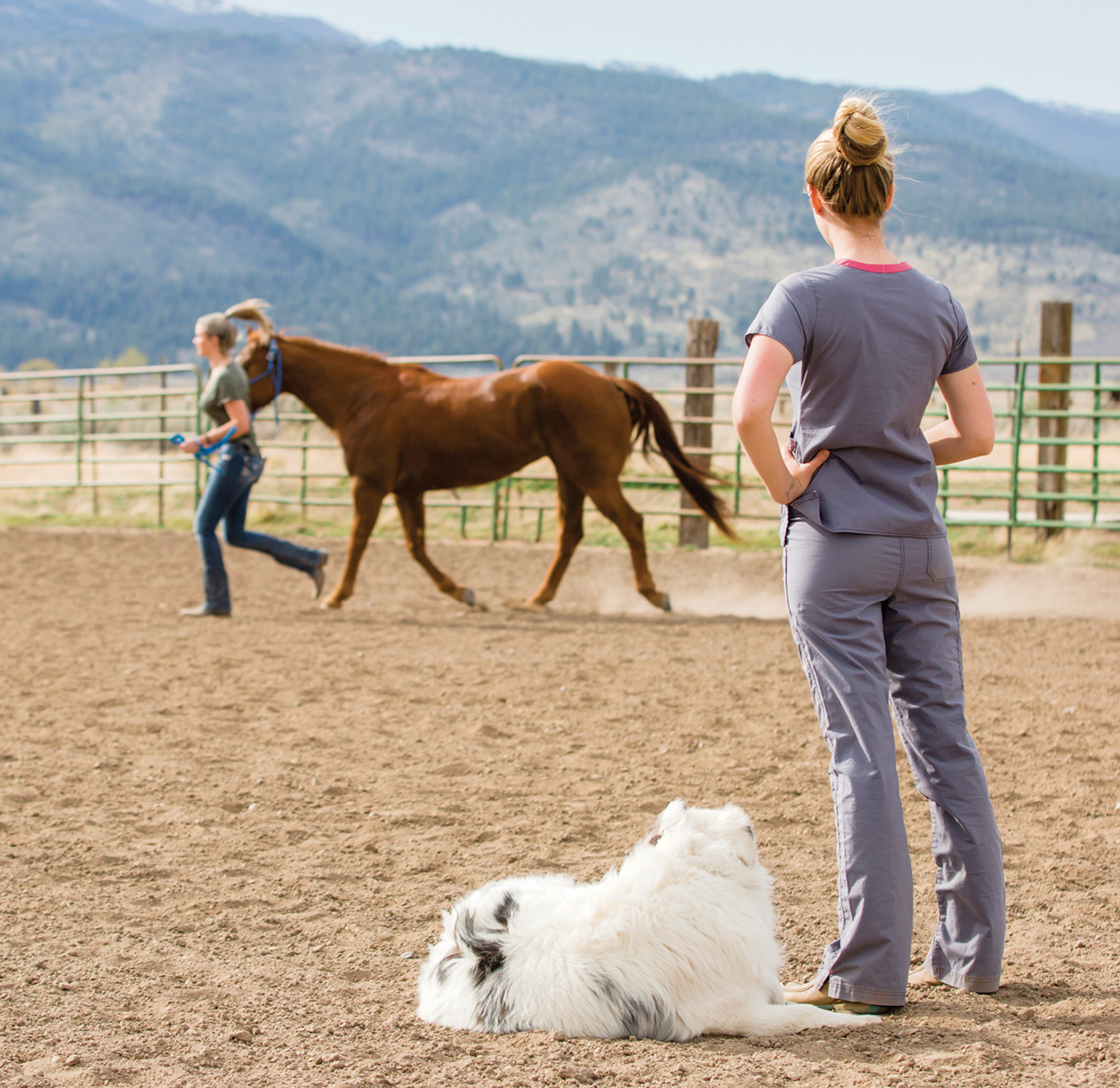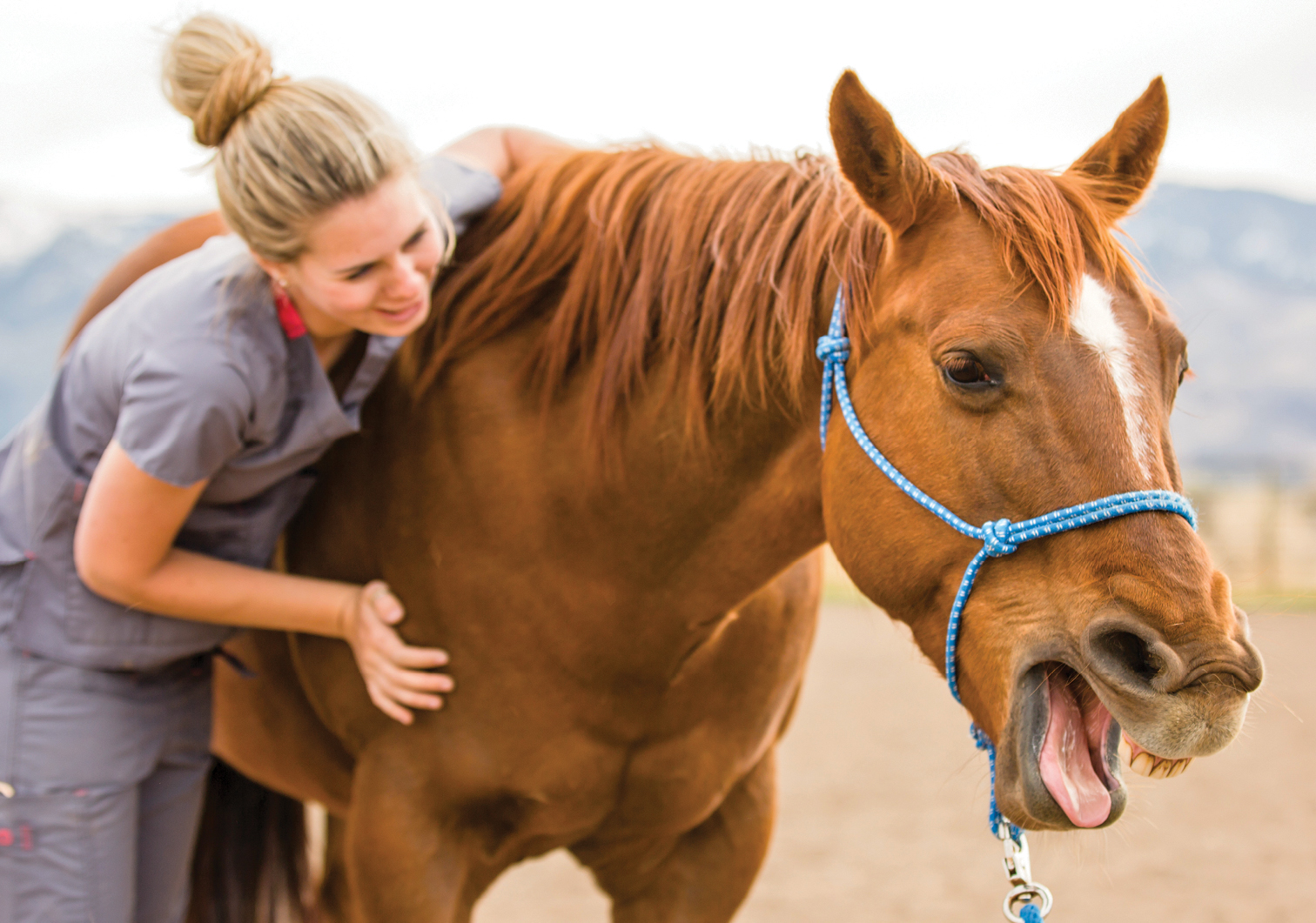The horse was staring at me from behind the bars of his stall. “Do something,” he seemed to say. He’d undergone a procedure called a “basket surgery” for his neck just three weeks before; now he had edema (swelling) in his sheath and all four legs, plus along his belly—likely the result of inactivity during his required stall rest.
[READ ABOUT: Complementary Care for Traveling Horse]
I would’ve loved to introduce some hand-walking or other exercise to help mobilize the fluid, but in this case, strict stall rest was essential. Even minimal movement could cause a catastrophic shift in the metal baskets stabilizing his neck.
What to do? I instructed the owner to apply standing bandages, then on a whim called my favorite massage therapist, who had some training in circulatory massage. Within 24 hours of this horse’s first session, his owner called to tell me the edema was dramatically reduced. It continued to improve with weekly sessions—and equine massage therapy turned out to be all we needed to get this horse comfortably through his extended period of rest.
Equine massage may conjure up images of pampered show horses being rubbed down after intensive training sessions, but this therapy can do so much more than that. In fact, there’s a multitude of medical conditions you may never think about that can benefit from massage.
Here, I’ll explain the reasoning behind some of the most popular techniques used by equine massage therapists in practice. Then I’ll introduce you to some horses with a variety of medical conditions that benefited from these techniques. Finally, I’ll help you choose a massage therapist that has the training and experience your horse needs.
[READ ABOUT: Alternative Horse Therapy]
Massage Techniques
What really happens when your horse receives a massage? Therapists employ a confusing variety of techniques, made even harder to spell out because there’s little standardization related to these treatments. Similar (even identical) techniques are given different names by different “schools” or by individual practitioners.
We’ll focus on five techniques that might help your horse in a variety of situations: basic massage, trigger-point therapy, myofascial release, manual lymphatic drainage, and stretching.
We’ll look at each in turn.

[READ ABOUT: Horse Injury Healing Options]
Basic massage. These techniques involve applying firm pressure to muscles and other underlying soft tissues such as the fascia, or connective tissue surrounding muscles. The muscles are typically warmed up prior to deeper work; strokes used might include percussion (gentle tapping to warm the muscles and encourage blood flow), effleurage (light to firm stroking), and compression (application of deeper pressure).
Methods of application during a typical massage session vary widely, depending on both the preference of the therapist and the preference of the horse. Basic massage techniques are at the foundation of most equine massages, whether the goal is to spoil a pampered show horse or help with the management of a serious underlying medical problem.
Trigger-point therapy. Trigger points, often described as “muscle knots,” are sensitive spots causing pain in soft tissues. Although the precise underlying cause of these painful points isn’t known, many experts believe they’re likely associated with a small patch of contracted muscle. This chronic contraction causes constricted blood supply to the area, a build-up of lactic acid, and an eventual vicious circle of spasm and pain.
A skilled therapist can identify a trigger point as a small, firm area within the muscle, where if pressure is applied directly to that point, it can result in direct pain, small (sometimes visible) spasms or twitches, and/or pain referred to another location.
Trigger points can occur as the result of hard work, stress, or injury. When practicing trigger-point therapy, your massage therapist applies direct pressure to relax the muscle, release lactic acid, relieve spasms, encourage blood flow, and improve the oxygen supply.
Myofascial release (MFR). Fascia is a dense, strong tissue that surrounds and supports structures in the body, including muscle, bone, nerves, and the internal organs. Myofascia refers specifically to fascia surrounding the musculoskeletal system—it’s the strong, white, stringy stuff you peel away when preparing a chicken breast.
In a normal horse, fascia provides support, but it’s relaxed and soft, causing no restrictions to muscular contraction or joint movement. Fascia can cause problems, however, when it becomes tight and restrictive as the result of trauma, disease, or plain old hard work.
A therapist trained in MFR will recognize these areas of restriction and employ stretching and manipulation techniques to release this tension and restore free movement. Some MFR techniques may cross over with trigger-point therapies by targeting trigger points within the fascia.
Manual lymphatic drainage (MLD). Edema, or fluid accumulation in the tissues, is a common problem that can occur as the result of a variety of issues, ranging from an allergic reaction to a response to injury or simple inactivity. Picture the older horse on stall rest who stocks up in all four legs, or the horse with a thick plaque of edema on his belly following a severe case of hives.
In order for the edema to resolve, the fluid must be taken up by the lymphatic system. Natural mobilization of excess fluid can be an inefficient process, made even more difficult because of the horse’s large size. Successful resolution often depends on exercise, which isn’t always possible. Enter MLD. The therapist performing it will begin by applying a series of massage strokes that encourage circulation in the tissues, followed by a specialized system of manipulations designed to mobilize that excess fluid and encourage it to travel to the lymphatic vessels so it can be cleared. Compression bandages of the lower legs will often be recommended following this therapy.
Stretching. Many different types of stretching can be beneficial for increasing flexibility and joint range-of-motion, or for improving the overall health of the musculoskeletal system. It’s important to understand the difference between dynamic and passive stretching.
Dynamic stretching (such as a carrot stretch) allows the horse to be involved in the “decision” about how far to stretch—making it a safer technique in untrained hands. Passive stretching (the human performs the “stretches” on the horse) has some solid science supporting its benefits for muscle health, but it also carries risk of injury—making it extremely important that the therapist is well trained and experienced.
A therapist performing passive repetitive stretching will guide the joints through a series of movements several times, pausing only very briefly (one to two seconds) at the end of each range of motion.
[READ ABOUT: Horse Stretching Exercises]

Meet the Patients
Now let’s meet three horses that’ve benefited from equine massage therapy techniques that go beyond the basics.
Cleo is a 20-year-old Welsh Pony with Cushing’s disease and chronic laminitis, living out her days in a stall and large paddock. Her laminitis is fairly well controlled with corrective shoeing and the occasional dose of bute, but her owner noticed that the muscles in her hindquarters had become hard as rock.
The treatment: Cleo’s massage therapist performed basic massage techniques along with trigger-point therapy and some myofascial release targeting the strong bands of fascial tissue over her hindquarters.
The result: Cleo became much more comfortable almost instantly. Her owner noticed she was moving around her paddock more, and even her feet seemed to improve after treatments. Monthly visits from the massage therapist became a part of her regular management.
Gerald is an 18-year-old Quarter Horse gelding who fractured his elbow in the pasture. It was surgically repaired, but now he’s on stall rest and facing an extensive rehabilitation. Gerald has always stocked up a little bit, but lately it’s been much worse. All four legs, plus his sheath, are swollen.
The treatment: Manual lymphatic drainage was performed to help relieve the edema, followed by the application of standing bandages. This well-trained therapist consulted with Gerald’s veterinarian prior to administering any treatment because he recognized how important it was to account for Gerald’s surgery and proper management of that limb.
The result: The edema improved significantly following the first treatment, so appointments were scheduled every two weeks during Gerald’s period of stall rest. By the time he was ready to begin the controlled exercise portion of his recovery, the edema was almost completely resolved.
Dakota is a 10-year-old Arabian endurance horse who injured his suspensory ligament during a ride. He had aggressive treatment for the injury, then was started in a rehabilitation program. His owner simply wanted to “do what’s best” to make sure Dakota healed as well as possible.
The treatment: Dakota’s massage therapist used a variety of techniques during his rehabilitation, including basic massage, trigger-point therapy, and stretching exercises.
The result: By the time Dakota’s suspensory ligament had healed, he was in great shape and ready to go back to work. He’d experienced minimal loss of condition while on stall rest.
The overall take-home message? While equine massage therapy has become almost mainstream for the elite equine athlete, it’s often overlooked for other horses. Be sure to ask your veterinarian if massage therapy could be beneficial whenever your horse is diagnosed with a medical problem or is recovering from an injury.
Selecting a Therapist
A well-trained therapist can be a critical member of your horse’s health-care team. Selecting a therapist can be challenging, however, as few rules exist to regulate equine massage and bodywork. That means making a good decision requires research on your part.
Here are questions you should ask.
1. What training have you had? Answers to this question are likely to range from “my farrier taught me, and he’s a really good guy,” to “I’m certified by a program that requires courses in anatomy and physiology, has veterinarians on their faculty, and administers testing prior to certification by that school.”
Be aware that even if the therapist attended a “school,” the amount and quality of training ranges from a weekend course to years of study. Take time to check out the training program online, and look for courses in horse handling and anatomy, as well as whether veterinarians are involved with the education.
2. Are there any laws restricting the work you do? Laws related to equine massage therapy and bodywork vary widely from state to state. As examples, in Oregon, practitioners can work only with veterinary referral, and in Colorado and Washington, a written examination is required. Other states require direct or indirect veterinary supervision, and some have no laws at all.
While the legalities might not directly impact the quality of a therapist’s work, there’s an ethical question at hand—that is, if a practitioner is willing to break the law, is that someone you trust to work on your horse?
3. What techniques do you use? Find out what tools your chosen therapist has in her toolbox to make sure she can meet your horse’s needs. For example, if chronic stocking up is a problem you’re trying to address, confirm that the practitioner is has been trained in manual lymphatic drainage (MLD).
4. Do you have a relationship with a veterinarian who can recommend your services? Most well-trained massage therapists have a relationship with a veterinarian, even if veterinary referral isn’t required in their state. Ask your therapist for a recommendation from a veterinarian, then call that veterinarian for input.
5. Do you have insurance? Your massage therapist or bodyworker should have liability insurance.
Editor’s note: Thank you to Sabina Pariser of West Winds Equine Massage in Portland, Oregon, and Debranne Patillo of Equinology Inc. based out of Napa, California, for help with this article. Thanks also to Kaely Juzek, the massage therapist in the photos. Juzek’s Destiny Equine massage business is located in Reno, Nevada; Juzek was also Miss Reno Rodeo 2018.

